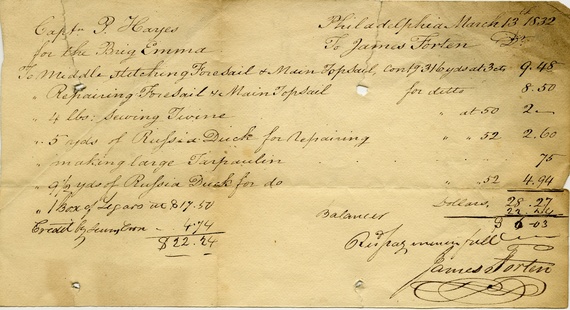Co-authored by Ellen M. Snyder-Grenier
As you make the rounds of the exhibition Tides of Freedom you cannot miss James Forten's bold flourish of a signature on this handwritten sales receipt. It was March of 1832, and Forten -- a successful African American businessman in early 1800s Philadelphia -- had just sold sails to white Captain Patrick Hayes of the brig Emma.
The receipt is extremely rare. Not only does it document an early black-owned business, but also it shows us the signature -- the name -- of a remarkable individual. James Forten was a model of how and where America could go if it would release itself from the limiting ideas that enslavement had imposed on everyone.
Forten was the well-to-do owner of his own sailmaking loft, located along the Delaware River in Philadelphia, the nation's shipbuilding center (and his home). He had been born free, had fought in the Revolutionary War, had been captured and released, and returned to Philadelphia to take over the sailmaking business from his father' white employer, Robert Bridges.
It was an exhilarating time. The years following the Revolution's end in 1783 were filled with promise that those tortured under slavery could become full citizens in American society. In 1780, Pennsylvania's legislature had passed an Act for the Gradual Abolition of Slavery; anyone born enslaved would be emancipated -- freed -- when they turned 28. By 1799, almost one in ten Philadelphians were black and most were free.
In his waterfront sail loft, James Forten created a dream of equality -- a place where black men and white men worked side by side. A visitor described the scene:
In one, his workmen, 20 or 30 in number, were industriously at work upon the canvass [sails... These were white men, but not so all. As near as I can recollect, about half of them were colored. My friend remarked to me that both colors had thus been employed together for more, I think, than 20 years, and always with the same peace and harmony which I then saw. "Here," said he, "you see what may be done, and ought to be done in our country at large."
The dream of racial harmony that Forten imagined, created, and nurtured along the Delaware would be a fragile one, one battered by the continuing legacy of slavery. And yet within the binding constraints of that legacy, many, like Forten, would forge routes to justice, equality, and liberation.
We know their names. There was free merchant and ship captain Paul Cuffe (1759-1817) -- a friend of Forten's -- who looked at the Delaware River as the first leg of a passage to liberation. Cuffee believed the only route to equality was to return home, to Africa. And so on January 1, 1811, he and his crew of nine black seamen left Philadelphia bound for West Africa's Sierra Leone, a British settlement that had become home to hundreds of people freed from enslavement.
Frederick Douglass (1818-95) saw the river as the last leg of his route to freedom. Enslaved in Maryland, when he was 20 he made the decision to take his liberty. "[At] Wilmington... we left the train," he said, "and took the steamboat for Philadelphia. In making the change here I again apprehended arrest, but... I was soon on the broad and beautiful Delaware, speeding away to the Quaker City." Douglass would go on to become a leader in the national and international conversations about slavery, race, and equality.
William Still (1821-1902), the freed son of enslaved parents, made the Delaware River into a leg of the Underground Railroad. Because the port of Philadelphia was a destination for boats traveling north from slave states, he helped self-emancipating men and women runaway from enslavement, and facilitated their use of the river as a watery highway to freedom. Later, he published their heroic stories of self-emancipation.
For 18-year old Lear Green (ca. 1836-57), the Delaware was a risk-filled path of hope. In 1854, with the help of her free fiancé and his mother, she shipped herself, inside a sailor's chest, aboard a steamer bound for Philadelphia from slaveholding Baltimore. After 18 hours, dockworkers in the City of Brotherly Love unknowingly unloaded her onto a wharf -- and into freedom. "She declared," said chronicler William Still, "that she had no fear."
An enslaved Jane Johnson, mother of two, emancipated herself and her children in 1855, when her southern master decided to stop in Philadelphia on their way north. Johnson decided to walk off their ferryboat. When her master protested, black abolitionist William Still and white abolitionist Passmore Williamson, along with five black dockworkers, came to her aid. Bravely, she and her sons stepped off the ferryboat onto Walnut Street Wharf. "I went away of my own free will," she would later say; "I always wished to be free and meant to be free when I came North."
It would take the Civil War -- a war in which the service of enslaved and free descendants of Africa would be key to the Union victory -- to truly change the tide. As war raged from 1861 to 1865, with it came a chance to redefine the meaning of freedom and democracy in America. Indeed, the defeat of the slave holding southern states was a victory for freedom and equality. Emancipation redefined freedom.
That redefinition would be tested after the war. But James Forten's vision -- and the many courageous stories of others along the Delaware -- remind us that freedoms are hard won by those willing to sacrifice to make the world a better place.
Next installment: Jim Crow
Ellen M. Snyder-Grenier is an independent curator, exhibition developer, and writer, and principal of REW & Co.
Image is of a receipt from James Forten, 1832, Courtesy of the Collections of Independence Seaport Museum, Barry-Hayes Papers, gift courtesy of Florence, Austin B. and William Hepburn
